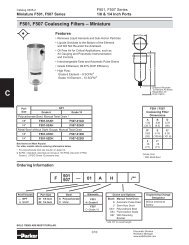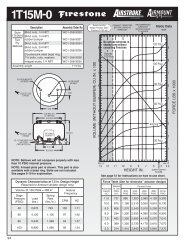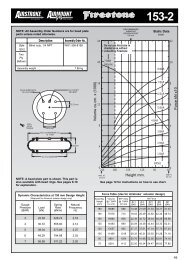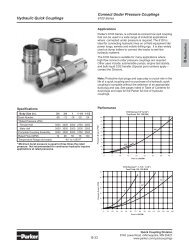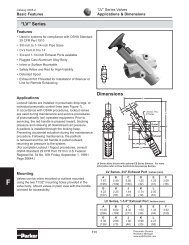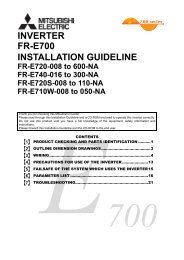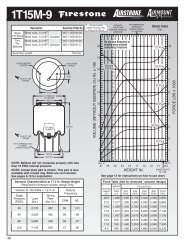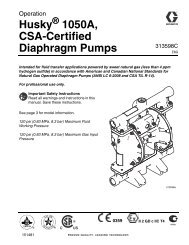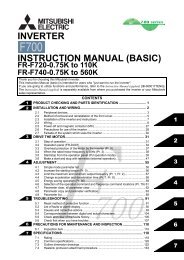Parker Industrial Hose Catalog 4800 - MRO Stop
Parker Industrial Hose Catalog 4800 - MRO Stop
Parker Industrial Hose Catalog 4800 - MRO Stop
Create successful ePaper yourself
Turn your PDF publications into a flip-book with our unique Google optimized e-Paper software.
HOSESafety & Technical DataSafetyGeneral: Safety in the application and use of industrial hoseis a major concern because of the many potentially dangerousproducts conveyed, and because so many people areinvolved. Handling these products can be accomplishedsafely if a few simple precautions are strictly observed.Some of the most important of these are:• All operators must be thoroughly trained.• The correct hose must be selected to handle theapplication.• The couplings must be correct for the applicationand also must be securely attached.• Both hose and couplings should be well maintainedand inspected regularly (pages 188 through 192).Critical Items: While many industrial hose applicationsare potentially dangerous, a few are of particular concernbecause their danger is not always so obvious or generallyunderstood. This is particularly true for non-industrialapplications where there is greater potential for operation byuntrained personnel. A discussion of some of the more commonof these follows. (ordering information for RMA publicationsis on page 223).Gasoline Pump <strong>Hose</strong>: The proliferation of self-servicegasoline stations has created a situation where millionsof consumers are daily operators of gasoline pumps. Thishas greatly increased the concern of station operators andsuppliers for equipment safety. Gasoline pump hoses inparticular are subject to frequent abuse by daily wear andaccidents. <strong>Hose</strong> selection must include consideration of theamount of use and abuse it must withstand during its servicelife. Only the highest quality, thoroughly tested, UL listedhose must be selected for that service. The proper hoseplus constant inspection is the best protection against useraccidents. DO NOT USE GASOLINE PUMP HOSE FORFUELING OF AIRCRAFT.Purchase at http://www.mrostop.commale swivel end styles are not recommended. DO NOT USEWITH SCREW-TOGETHER REATTACHABLE COUPLINGS.<strong>Parker</strong> LP Gas <strong>Hose</strong> is listed in the LP Gas section of thiscatalog. (Refer to RMA Publication IP-10 "Liquid PetroleumGas, Specifications for").WARNING ! For LP Gas use ONLY. Do not use foranhydrous ammonia. Do not use with male swivel couplings.Do not use with screw-together reattachablecouplings.Anhydrous Ammonia (NH 3) <strong>Hose</strong>: Contact with AnhydrousAmmonia will burn skin, and is especially damaging tothe eyes and lungs. This is true for its liquid and gaseous(vapor) state. Many accidents involving NH 3have occurredby using the wrong hose. NH 3hose must be specially compoundedand constructed to handle the material, and otherhoses may fail very quickly and suddenly. It is, therefore,especially important to make sure that only AnhydrousAmmonia hose is recommended and used for this service. Inparticular, LP Gas hose is not recommended for anhydrousa m m o n i a ! service. This is important to emphasizebecause both types of hose are often used in the same areaand care must be taken they do not become accidentallyswitched. DO NOT USE ANHYDROUS AMMONIA HOSEFOR LP GAS OR REFRIGERATION SERVICE. Couplingsare also a concern in this application; permanent steelcrimp couplings are recommended. Couplings with maleswivel end styles are not recommended. <strong>Parker</strong> AnhydrousAmmonia hose is listed in the Acid & Chemical section ofthis catalog. (Refer to RMA Publications IP-14 "AnhydrousAmmonia <strong>Hose</strong>, specifications for" and IP-11-2 "AnhydrousAmmonia <strong>Hose</strong>, Manual for Maintenance, Testing andInspection").WARNING ! For anhydrous ammonia use ONLY. Donot use in LPG or refrigeration applications. Do notuse with male swivel couplings. Do not use with screwtogetherreattachable couplings.LP Gas <strong>Hose</strong>: This discussion again emphasizes theimportance of hose selection. LP Gas has volatile characteristicsthat require special hose construction. The rubbercompounds must be designed to handle LP Gas, and thecover must be perforated to prevent gas build-up amongthe various layers of the hose. Use of the wrong hose maylead to early and sudden failure. In particular, anhydrousammonia hose is not recommended for LP Gas service. Thisis important to emphasize because both types of hose areoften used in the same area and care must be taken they donot become accidentally switched. DO NOT USE LP GASHOSE FOR ANHYDROUS AMMONIA. Couplings are alsoa concern in this service; permanent crimp steel couplingsare recommended, as well as high pressure steel insertsattached with interlocking, bolt-on clamps. Couplings withNatural Gas: The molecules of natural gas are small,enhancing its ability to permeate through standard rubber orPVC hose constructions. The permeation process is morerapid as the working pressure increases, and natural gasaccumulates with potentially dangerous consequences. Usepipe, non-permeable tubing or hose with barrier constructionsto convey natural gas. Series 7132/7232 L.P. Gas <strong>Hose</strong>can be used for natural gas service, but only under the followingconditions:• Maximum working pressure of the application notto exceed 50 PSI.• The application must be in an outside or openenvironment.• Applications that are in an enclosed environment orgreater than 50 PSI working pressure are not!200<strong>Parker</strong> Hannifin Corporation<strong>Industrial</strong> <strong>Hose</strong> Productswww.safehose.com



